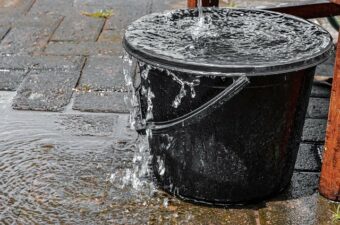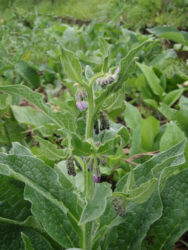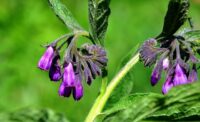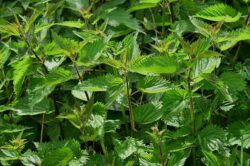In this article, we will be discussing whether comfrey or nettle tea or both are better in the garden. In my various articles, I have talked about several fertilisers both inorganic and organic from growmore, fish, blood and bone, Seaweed extract, Q4 Fertiliser, Phostrogen and many more. It is time to see if there is an alternative.
WHY USE NETTLES AND COMFREY?
It is possible to grow your own fertiliser and use it in the garden and hence why comfrey or nettle comes into play. What is great about these plants is that they are often found growing in your garden, such as comfrey or in fields nearby such as nettles. The best thing about all these fertilisers can be made for very little cost to you.

Some plants you find growing in gardens, grow so vigorously that you wonder if they can pass this vigour to other plants. The good news is that some of these plants can, as they can supply other plants with their nutrients. Two of the best for doing this are comfrey and nettles, although some other plants can be used.
You may not have comfrey plants in the container garden, but with a little investment and a few containers, you can soon have a supply of leaves to make fertiliser with. It may take some investment and time, but once established you can reduce your dependency on other fertilisers in the garden. Reduce but not totally eliminate as you would need a lot of plants to make your fertilisers. Nettles is not as good but still has some fertiliser potential in the garden.
WHAT IS COMFREY?
Comfrey or Symphytum officinale and Symphytum asperum to give its proper name are a deep-rooted, hardy perennial that is found all over the land. Its hairy, green leaves are high in potassium, an important primary macronutrient, with good levels of nitrogen and phosphorous. As it has all three primary macronutrients, it makes a good all-rounder in the garden.
If you can find it growing in fields, you can try asking the landowner if you can harvest a few leaves. It is such a vigorous grower that it should recover within a few weeks. It is important that when you pick the leaves that you do not take too many, as this can reduce the vigour of the plant.

The common wild forms are a useful addition to the compost bin and the cultivar Symphytum x uplandicum has been specifically developed to produce leaves and no flowers. It spends all its energy on the producing of leaves instead of blooms. This makes an even better fertiliser. Comfrey can be directly added to a compost bin to act as an activator to speed up the composting process.
This is why it is great growing near compost bins, where the leaves can be directly added when needed to produce a better quality of compost. The common comfrey tends to seed freely and you will make new plants readily, appearing everywhere. If you do not want to buy a plant, you can beg a division or some seeds from friends and neighbours, where they can be sown in autumn,
You will soon have more that you know what to do with. For S. x uplandicum as no flowers are produced you have to rely on root cuttings to propagate the plants.
HOW TO MAKE COMFREY TEA
This potent brew is made from steeping comfrey leaves in water. It can be used as a general-purpose fertiliser or it can be used as a plant general pick-me-up. On newly plants, it is best to wait until the plant has established well, which can take up to one year.

Once established, you can harvest leaves when required, whilst sending any flowering stems to the compost bin. Harvest the leaves right down to the ground to stop them from rotting on the plant itself. Established plants can be harvested 4 times a year, taking a few leaves at a time. You can, therefore, make fertiliser up to 4 times a year, which may suit some people more than others.
What you need to do is stuff as many leaves into a large bucket as possible. It does not matter if it is fresh or wilted leaves are used. Once inside the bucket, you can chop the leaves to a smaller size as possible using a pair of shears, fill the container with water up to the level of the leaves, and place a lid on, such as a paving slab and then wait. The exact ratio of comfrey leaves to water is not too important but you do not want to make the mixture too dry.
After ten days or two weeks, the comfrey and water will have started to ferment and bubble away. By covering the bucket, you will accelerate the decomposition process as well, but it will still take two to three weeks to brew to the right strength.
USE YOUR NOSE TO TELL IT IS DONE
The smell is one of the best indicators that the brew is going well. If you cannot go near it because of the odour then it is nearly ready. This is because comfrey smells as it rots and this is why you need a tight-fitting lid. You do not want to upset your neighbours with the fouls odour. It must be remembered you are doing it for your plants and not for you directly.
As said before, it is not an exact science, some people make it dilute, whilst others make a concentrated fertiliser that will need diluting. The method that has been described will require no dilution. The concentrated solution stores better than the dilute one, so if you want a fertiliser that can be used when needed, it is better to go for the concentrated concoction. This is made by having one part water to 10 parts comfrey.
The nitrogen-phosphorous-potassium ratio of dried comfrey is 3: 2: 4.8 and it contains calcium as a bonus. Is it food enough to use on its own? The answer is yes and no, as it does have nitrogen and potassium in reasonable amounts, but its phosphorus content is too low for most rooting plants.
IT CAN BE USED THROUGHOUT THE GARDEN
If you are using it throughout the garden, you will need to use freely. I think it is a great additional supplement to fertilisers but it does not replace them. It is not a miracle worker that some gardeners make it out to be. To use it, you will need to fill the liquid and place it in a watering can and dilute if you have made a concentrated (10 parts comfrey to 1 part water) form or not if you have made a diluted one. You will then need to apply it every 2 weeks during the growing season.
There are problems associated with the use of comfrey tea. The main being is that if you have a large garden, you will need a lot to feed all your plants. To do this every 2 weeks seems not to be practical to me. This is why you say that comfrey can be seen as a supplement with other fertilisers that can be made quickly and cheaply.
If you do not have the time or the patience you can buy comfrey fertilizer concentrate already made.
NETTLE TEA
Similarly, stinging nettle can be converted to nettle tea. This will be easier to do as nettles tend to be more widely available, growing widely in fields and lanes. Do not use nettles that are growing near busy roads, as they may be sprayed with weed killers. Always use nettles that look healthy and growing in remote spots.

As you imagine nettles are difficult to pick, so you will need thick gloves to handle them, otherwise ouch.
For dilute mixture equal amount of nettles and water will make ready to use solution.
To feed your plants. If you want to make a concentrated mixture use 1 part water to 10 parts stinging nettles. This will need to be diluted when using it by adding 1 part tea per 10 parts water. This will give you a more beneficial solution to the garden, but you will need to brew it regularly, Nettles has nitrogen: phosphorus: potassium ratio of 5.7: 0.7:3.7
COMFREY VERSUS NETTLES, WHICH IS BETTER?
As you can see comfrey has better nutrient values than nettles, but them yet again nettles are easier to find and harvest. You can harvest comfrey 4 times a year, and so you are limited to how much you can brew from your existing plants. Nettles tend to be poorer in nutrients, especially potassium. You can say that nettles tend to be higher in nitrogen and comfrey tends to be higher in potassium.
This would mean that nettles are good for growing leafy plant, whilst comfrey is better for blooms and fruits. They can complement each other, each tends to be poor in phosphorous and so will not be adventurous for plants to develop a good root structure.
Nettle may be beneficial in the early season when plants need nitrogen and produce all the leafy growth, whilst comfrey should be used once your plants start developing its beautiful blooms.
Both are good and have uses in the garden, but I would say that they are not balanced fertilizers and that they are organic fertilizer that will do the job better such as seaweed or fish, blood and bone.
The smell when you make it is a smell you will soon not forget. Your nose may never forgive you for exposing it to it. They are viable fertilisers but not the best.
If you have any questions and comments that you wish to make on this important topic, please do so in the comment box below.
Do not get stung but use your head.

Both tea fertilisers have the good and bad sides. Comfrey has more nutrients, but the harvest is limited. Nettle on the hand has more harvest times but lacks some nutrients. I think making a choice between the both do them would be about preference and purpose/use (that is either for business use or for personal use).
Hi Nelson
As everything in life it is a balance between the two options of availability and value. If you can find both I always recommend that you use them but as said in the article you can buy it if you do not have the necessary ingredients or if you do not have the time and patience. Good luck
Antonio
This is amazing, I am a poultry farmer and I am used to using my poultry dung as fertilizers for my maize farm and when we want to use it for our garden we have to pour water on it. I never thought of using a plant to produce organic fertilizers. I have nettles readily available in my environment. I will harvest some and try it out.
Hi Parameter
It is amazing how you can use widely away plant products in your garden, and nettles and comfrey seems to be the best. It will cut your dependency on artificial fertilizers but if you have large areas it can be bothersome to create a lot. I am glad you are trying it out.
Thanks
Antonio